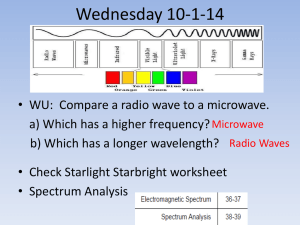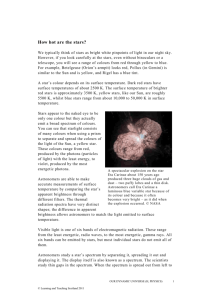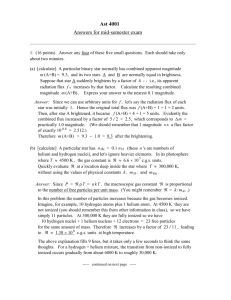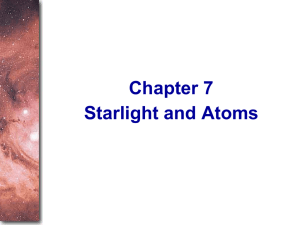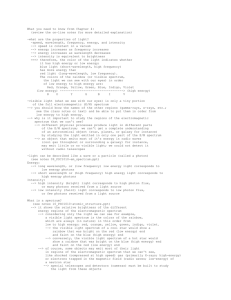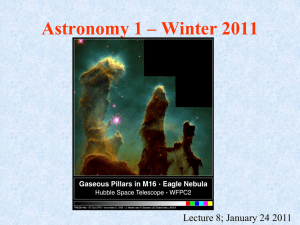Temperature, Color, Radius & Composition
advertisement
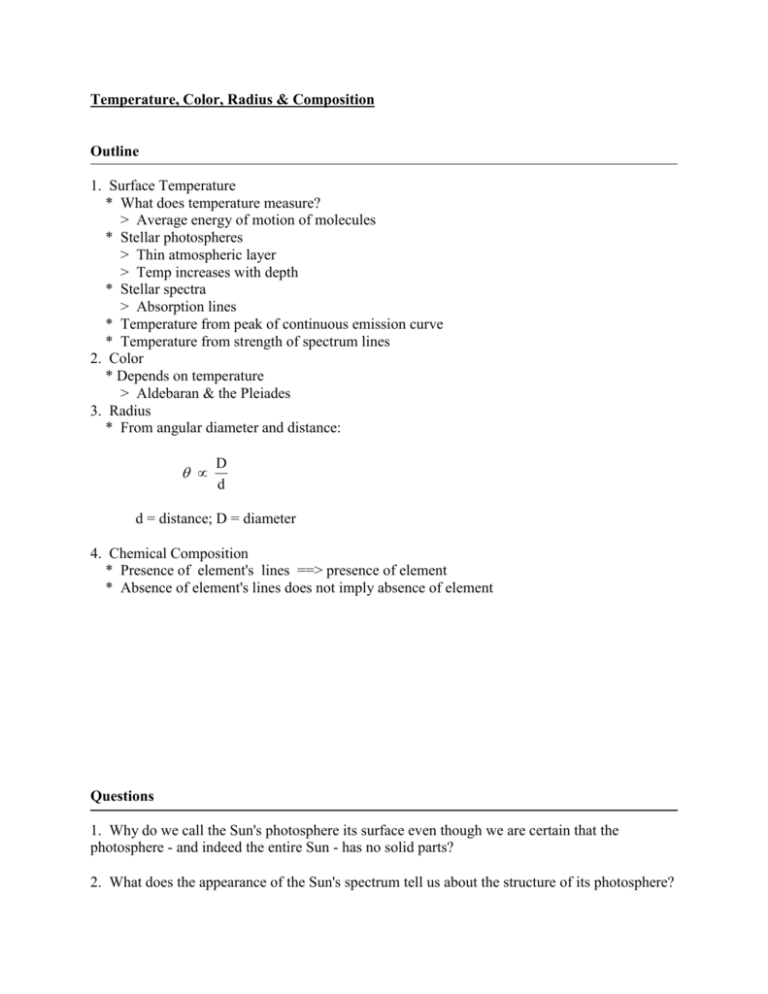
Temperature, Color, Radius & Composition Outline 1. Surface Temperature * What does temperature measure? > Average energy of motion of molecules * Stellar photospheres > Thin atmospheric layer > Temp increases with depth * Stellar spectra > Absorption lines * Temperature from peak of continuous emission curve * Temperature from strength of spectrum lines 2. Color * Depends on temperature > Aldebaran & the Pleiades 3. Radius * From angular diameter and distance: D d d = distance; D = diameter 4. Chemical Composition * Presence of element's lines ==> presence of element * Absence of element's lines does not imply absence of element Questions 1. Why do we call the Sun's photosphere its surface even though we are certain that the photosphere - and indeed the entire Sun - has no solid parts? 2. What does the appearance of the Sun's spectrum tell us about the structure of its photosphere? 3. According to the first figure below, at what temperature are hydrogen lines most prominent? Is your result consistent with the appearance of the second figure? 4. Use the second figure above to sketch a line strength vs temperature graph for Na I (neutral sodium). Speculate as to why Na I lines disappear at high temperature. [The Na I line is the one marked with the 'happy face.'] 5. Use the figure below to estimate the colors of stars having the temperatures depicted. Carefully explain your reasoning. 6. At Pluto's average distance from the Sun ( about 40 AU), what is the angular diameter of the Sun? Compare this angular diameter with the angular resolution limit of the eye, ~ 1/60o; for angles smaller than this, objects tend to look 'point-like.' 7. What is the primary chemical composition of most stars? 8. Why is the relative strength of the absorption lines in a star's spectrum not necessarily a good indicator of the chemical composition of the star's photosphere? entirely of hydrogen and helium. Answers 1. Although the sun's photosphere is not solid - like an ordinary 'surface' - we call it the sun's surface because this is the region of the sun's atmosphere where most ofthe sun's light that we see originates; we see no photons originating in deeper layers. 2. The presence of absorption lines implies that the photosphere must consist of a relatively cool, low-density layer of gas overlying a hotter, denser region. The hot dense region produces the background (approximate) black body spectrum ("continuum") on which the absorption lines are superimposed. This hotter, denser region is surely gaseous as well. 3. According to the first figure, hydrogen lines should be most prominent at a temperature of about 10,000 K. In the second figure, it would appear that hydrogen line strength peaks near 10,000 K (Spectral Type A0), so the two figures would appear to be consistent with each other. 4. Here’s a rough sketch: 5. 3000 K: This star would have an orange tint. The visible spectrum is located on the part of the black body (continuous) radiation curve such that the red/orange/yellow part of the spectrum is brighter than the blue/violet part of the spectrum. Thus, the longer wavelengths should dominate this star's light. 6000 K: The continuous radiation curve peaks in the yellow/orange, but there's not much difference in brightness across the spectrum. All colors mixed equally would yield white light, but in this case the light probably has a slight yellowish tint. 12,000 K: Here, blues and violets are much brighter than oranges and reds. Thus, this star ought to have a definite bluish cast. 6. At 1 AU (Earth's distance), the Sun's angular diameter is 0.5o. So, at Pluto's distance, the Sun appears to have an angular diameter of 0.5o/40 = 0.0125o. This is 1/80o. So, even if Pluto were bright enough to be observed by the human eye, it would look point-like (like stars). 7. Most stars consist mainly of hydrogen and helium. 8. The appearance of the absorption line spectrum is controlled almost entirely by temperature (See the second figure under Ques. 3 above). Despite the appearance of the spectra in this figure, most stars consist almost entirely of hydrogen and helium.
